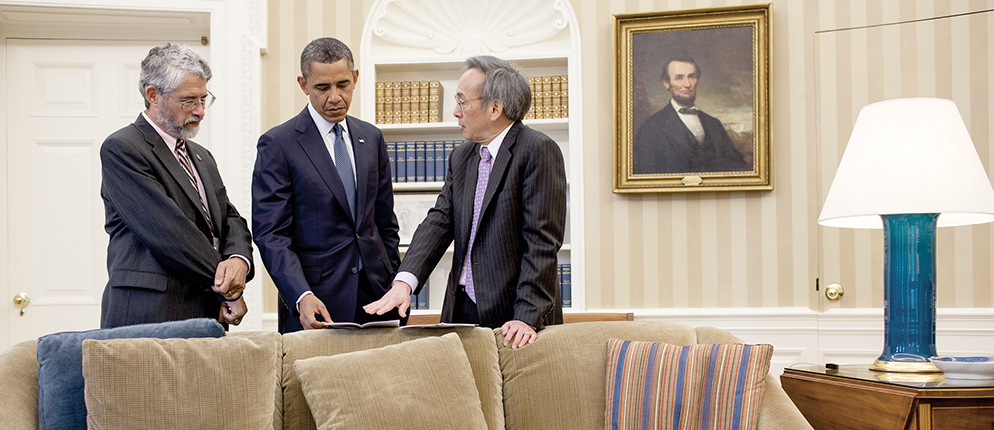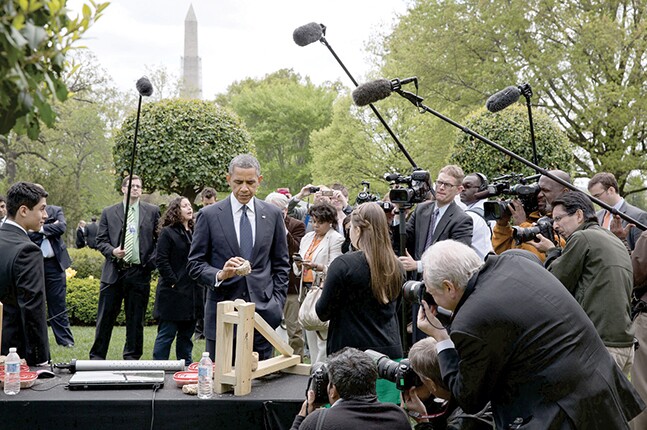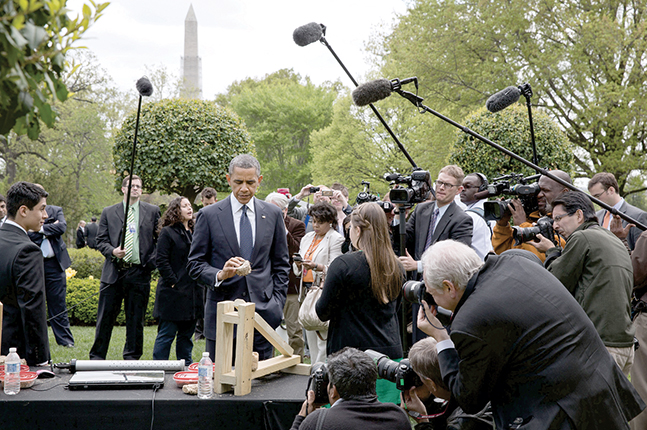President Obama’s science legacy is big on climate change and clean energy
DOI: 10.1063/PT.3.3390
In his inaugural speech in 2009, President Obama made a simple pledge “to restore science to its rightful place.” Today, as he prepares to turn over the Oval Office to Donald Trump, former top administration officials and academic observers say he kept that promise. Some experts, though, believe he took a wrong turn on space. The agenda he set on arms control and nonproliferation has only been partly accomplished, and the nation’s science education performance has improved only incrementally.
By all accounts, Obama personally has a high regard for science and the scientific method. “He’s a real intellectual; I’m not sure we’ll ever have another president as intelligent,” says former National Academy of Sciences president Bruce Alberts. “His whole ethos is scientific. He weighs evidence carefully and uses logic to make decisions.”
“Throughout his whole time in office, he has been very supportive of scientific research, including the more fundamental, more basic stuff,” says Steven Chu, the Nobel laureate physicist who was Obama’s energy secretary from 2009 to 2013.

President Obama meets in the Oval Office in May 2012 with science adviser John Holdren (left) and Steven Chu, who was energy secretary at the time.
WHITE HOUSE PHOTO BY PETE SOUZA

Federal funding for R&D received an immediate shot in the arm with the American Recovery and Reinvestment Act (ARRA) of 2009. Passed in response to the Great Recession, ARRA provided a one-year bonus of $18 billion in R&D spending for the National Institutes of Health, Department of Energy, NSF, NASA, and NIST (see Physics Today, April 2009, page 22
Burton Richter, Nobel laureate and director emeritus of SLAC, says ARRA channeled billions of dollars into upgrading the basic-sciences infrastructures of DOE, NSF, and NIST. The money went to construction of “shovel-ready” facilities that were approved but awaiting funding. Three new buildings were erected at SLAC alone, he recalls.
Excluding ARRA, nondefense R&D spending rose 4.3% in constant 2016 dollars during the Obama years, from $67.3 billion in fiscal year 2009 to $70.3 billion in FY 2016, according to the American Association for the Advancement of Science. But there were some lean years, including several in which spending dipped to around $66.5 billion. For basic research (excluding ARRA), federal funding rose 6.6%, from $31.4 billion in FY 2009 to $33.5 billion in FY 2016.
“I don’t think anyone really expected the NSF budget would double,” says Arden Bement, who was NSF director in 2004–10. “Expectations and rational expectations are two different things.” Nonetheless, he says, NSF fared better than might have been expected, given caps on discretionary spending mandated by the Budget Control Act of 2011. Those caps, modified several times since, have allowed only incremental growth.
John Holdren, Obama’s science adviser, receives much of the credit for Obama’s high regard for science. “It’s clear to me that he really trusts [Holdren’s] judgment on things,” says Alberts. Bement agrees: “The relationship that John has had with President Obama has made all the difference in the world.” Because Holdren was designated even before the new president took office, Bement notes, he was able to select key staff for the Office of Science and Technology Policy (OSTP), which he also directs.
“Almost immediately [Holdren] had established a close relationship with the president, and got plenty of face time. That’s very unusual, and it says something about the openness of Obama to science,” Bement says.
Richter is somewhat less effusive. He notes that although Holdren had much greater influence than did his immediate predecessor, John Marburger, some previous science advisers, including D. Allan Bromley under George H. W. Bush and Neal Lane under Bill Clinton, were also effective.
Climate change and clean energy
Climate change is likely to be Obama’s most enduring science policy legacy. Holdren and Chu were strong advocates for action to mitigate climate change and concomitantly expand clean-energy use. Chu recalls speaking privately with Obama when he was being considered for the cabinet post. “He said that there were two things highest on his agenda: health care, and energy and climate change.”
Since 2008, with support from DOE, US wind-powered electricity generation has tripled and its cost has fallen 40%, according to the White House. In the same period, solar-power output soared 30-fold, as cost fell by up to 60% (see the 2015 report “Big growth ahead for green technologies
New standards imposed on automakers in 2012 will double average fuel economy and cut greenhouse gas emissions by 6 billion tons through 2025, and the first US standards for heavy-duty trucks, implemented in 2014, will lower emissions by 270 million tons by 2018, according to the OSTP.
Obama’s Clean Power Plan would impose reductions in carbon emissions from existing coal-fired power plants. The administration’s 2014 bilateral agreement with China, in which China pledged to begin reducing carbon emissions by 2030, “was the start of the deal that led to the Paris accord” in 2015, says Richter. He credits Obama for the success of the landmark United Nations accord, under which 195 nations promised to take action to mitigate climate change. Also in Paris, Obama and leaders of 19 other nations committed to double their annual spending over five years on clean-energy R&D, to $30 billion. The US currently spends about $6 billion annually on clean-energy R&D, more than one-third of the world’s total investment.
Alberts says Obama did about as much on climate change as he could with a Congress that didn’t share his concern and wouldn’t act on the issue. Chu agrees: “After control of the House shifted [to Republicans in 2010], and being a political realist, he said I’ve got to do things administratively, because you can’t overcome the resistance. And then the Senate changed [to GOP control in 2012] and you really couldn’t have legislation going through. It became impossible.”
The GOP-led Congress also lacked Obama’s enthusiasm for renewable energy and was hostile to the DOE loan-guarantee program that had been authorized by the 2005 Energy Policy Act signed by George W. Bush. The program—and Chu—drew particularly harsh criticism after solar panel manufacturer Solyndra went bankrupt in 2011, at a cost to taxpayers of more than $500 million (see the 2011 report “Chu says Solyndra was victim of collapsing solar panel prices
But Richter thinks the administration focused too narrowly on solar and wind. “I don’t think nearly enough money has gone into energy storage, and nuclear is going to be essential to get the job done,” he says.
Although the Advanced Research Projects Agency–Energy, which provides early-stage funding for clean-energy technologies, was created during the previous administration, initial funding for the program came from ARRA in 2009.
Obama’s other research programs include the BRAIN (Brain Research through Advancing Innovative Neurotechnologies) Initiative, an effort to picture the dynamics of the brain that Bement says “is where the next revolution is going to be over the next two decades.” (See Physics Today, December 2013, page 20
On the other hand, no progress was made in reducing the administrative burden imposed on federally supported academic researchers, says Alberts. As the number of regulations has grown dramatically in the past 20 years, he says, “it’s taking a lot of faculty time and required people at universities to monitor all of these things. It’s sapping the lifeblood of our creativity.”
Space
Perhaps the loudest criticism of the administration’s science record has been aimed at the space program. Soon after taking office, Obama canceled what had been the flagship of the Bush administration’s space policy: returning humans to the Moon. Instead, the president proposed to send humans to a near-Earth asteroid, a mission billed as a step on the way to the ultimate goal, Mars. More recently, the asteroid visit was scrubbed and replaced with a plan for a robotic spacecraft to pluck a boulder from an asteroid and place it into a stable orbit of the Moon. Astronauts would then visit the rock to examine it.
In a second major departure from Bush’s plan, the White House handed off to contractors the task of developing crew transports for the International Space Station (ISS) that would replace the space shuttle, which was retired in 2011.
Holdren has argued that the Moon program, known as Constellation, was billions of dollars over budget, years behind schedule, and siphoning money from other NASA missions. (See Physics Today, October 2016, page 27
Former NASA administrator Michael Griffin believes the administration’s course change was made “because they needed to do something other than what Bush was doing.” Constellation, he says, was viable, although it required another $3 billion a year. “From a strategic point of view, I thought upending a program which had very strong bipartisan support and nearly enough money to do what it was trying to do was a mistake,” he says.
Griffin says a NASA-developed ISS transport could have launched by early 2015. As it is, contractors SpaceX and Boeing have been delayed by “technical problems that were foreseen by many of us,” he says; by the administration’s estimate, the companies’ spacecraft won’t fly before 2018. In the meantime, the US continues to pay Russia $81 million each time it ferries US astronauts to the ISS.
Scott Pace, who directs the Space Policy Institute at the George Washington University, says NASA missed out on opportunities for international partnerships by abandoning the Moon mission. “The Europeans, Japanese, Indians, and Chinese all are talking about the Moon, so we are the ones out of step with the rest of the global community.” And although the Moon was a logical next step on the way to Mars, he says, the asteroid mission “is not a bad mission by itself, but it’s kind of a one-off.”
NASA’s science programs, Pace says, are living off missions that were begun in previous administrations. “The pipeline has gotten really thin. The next administration is going to find the cupboard rather bare when it comes to science, because things haven’t been done by this administration to set things up for the next one.”
Pace notes that the Mars 2020 rover is the sole large planetary mission in the works. The Earth science program has been dominated by climate-related missions, and just two of the top five missions prioritized in the prerecession 2007 decadal survey are moving forward. Pace does commend NASA for its focus on space weather, which he points out has applications for both homeland security and science.
Nuclear weapons and nonproliferation
In his oft-quoted April 2009 speech in Prague, Czech Republic, Obama spelled out a five-point agenda for reducing the nuclear threat: (1) cutting the number of nuclear weapons and working toward disarmament, (2) ending fissile materials production worldwide, (3) securing vulnerable nuclear materials scattered around the globe within four years, (4) “immediately and aggressively” pursuing ratification of the Comprehensive Nuclear-Test-Ban Treaty (CTBT), and (5) preventing Iran from developing nuclear weapons.
Obama’s top nuclear achievement is arguably the 2015 agreement with Iran for that country to severely curtail uranium enrichment and halt plutonium production in exchange for the lifting of economic sanctions (see Physics Today, December 2015, page 26
Linton Brooks, a former arms control negotiator and later administrator of DOE’s National Nuclear Security Administration, calls New START “a modest but useful step.” But negotiations by the two nuclear superpowers on further reductions can’t occur, he says, with bilateral relations at their worst point since the Cold War and the US accusing Russia of violating the 1987 Intermediate-Range Nuclear Forces Treaty by developing a ground-launched cruise missile.
Brooks says the Iran accord is “a reasonable deal”; his contacts in and outside government are divided on whether it might have been improved.
Much of the world’s vulnerable nuclear material has been secured, and half the countries that once possessed it no longer do. But the job is far from finished, notes Matthew Bunn of Harvard University’s Belfer Center for Science and International Affairs. Much of that roundup was achieved during the last eight years, accelerated by the four biennial nuclear security summits that Obama initiated (see the 2016 report “Coverage of Nuclear Security Summit presents confusing message
On the other hand, the administration expended little effort on convincing the Senate to ratify the CTBT, Bunn notes, and no attempt was made to negotiate a treaty to end fissile material production. Meanwhile, North Korea continues to defy the international community by developing and testing increasingly powerful nuclear devices and the missiles to deliver them. The North Korean nuclear problem may be insoluble, says Brooks. “We’re not going to go to war with North Korea to overthrow the regime. Absent that, I don’t see anything like the present regime getting rid of nuclear weapons.”
To Bunn, ending some cooperative programs with Russia in order to secure nuclear materials wasn’t in US interests. In October Russian president Vladimir Putin ordered the suspension of a 2000 bilateral agreement under which the two countries had each agreed to dispose of 34 tons of plutonium (see the 2016 report “Russia abandons plutonium destruction pact with US
Science education
“For the first time, more than 100 000 engineers are graduating from American schools every year, and we’re on track to accomplish my goal of training 100 000 excellent new STEM [science, technology, engineering, and mathematics] teachers in a decade,” Obama wrote in an 11 October op-ed for CNN. In addition to the 100Kin10 training program, which the OSTP says has already prepared 30 000 STEM teachers, the Obama administration has created programs aimed at improving K–12 STEM teaching and learning, including the privately funded Educate to Innovate, which raised more than $1 billion since 2009, and Change the Equation, a coalition of the CEOs of 33 companies that says it contributes more than $750 million and millions of employee volunteer hours each year.

President Obama, while touring exhibits from the April 2013 White House Science Fair, examines a piece of a wood-alternative fuel made from biomass waste.
WHITE HOUSE PHOTO BY PETE SOUZA

But a nationwide test administered in 2015 found no improvement since 2009 in students’ science literacy at the 12th-grade level and only modest gains in the 4th and 8th grades. The National Assessment of Educational Progress results released in October found that only 22% of US 12th graders, 38% of 4th graders, and 34% of 8th graders were proficient in science. The 4th-grade and 8th-grade proficiencies were up 4% from their 2009 levels.
Education secretary John King Jr says that 12th graders in the 2015 test cohort had already finished their elementary and middle school years by the time Obama’s new programs to improve STEM teaching took hold. He says 12th-grade improvement should be evident in the next round of tests. Adds Holdren: “We’ve known for a long time that it’s very important to reach kids early when they’re most impressionable, when they’re really deciding what they’re interested in. What we’re seeing is success in reaching kids in the earlier grades in a way that is making science more exciting.” Many of the Obama initiatives are only partially implemented, he says, and a new White House effort to bring computer science classes into all K–12 classrooms just kicked off in January.
But Alberts, who helped to develop STEM learning standards in the 1990s, says the Obama administration’s “top-down, command-and-control” enforcement of federally mandated standards is harming science teaching. Teachers are forced to devote an inordinate amount of time preparing students for multiple-choice tests that aren’t meaningful, he says, even though schools and school district performance are measured by the results. “It’s been incredibly destructive of teacher initiative and teacher esprit de corps and the empowerment of teachers that we really need,” he says.
Alberts also questions whether all the new STEM teachers are receiving quality training and wonders how many will remain in the profession given the “oppressive atmosphere” created by the emphasis on standards.
King replies that while adherence to state standards is important, “we of course want teachers to be creative and ensure that their classes are engaging and rigorous, not narrowly focused on assessments.” He says the Department of Education has just issued new regulations to “ensure greater transparency around the level of preparation of teachers” to meet state standards.
More about the Authors
David Kramer. dkramer@aip.org
